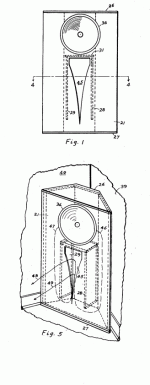Bet me re the 126.  It does if you want to get LF out of it with any semblence of dynamic BW in a back-load.
It does if you want to get LF out of it with any semblence of dynamic BW in a back-load.
Anyway, I didn't get chance to do any detailed tests, but like GM, I found under certain conditions the mass loaded tapped horn (BIB) was notably superior; particularly (and as you would expect) regarding their upper corner roll-off. Incidentally, properly executed chokes in horns are nothing new; Harry Olson advocated them back in the late 1930s & I don't recall many complaints about his designs.
Anyway, I didn't get chance to do any detailed tests, but like GM, I found under certain conditions the mass loaded tapped horn (BIB) was notably superior; particularly (and as you would expect) regarding their upper corner roll-off. Incidentally, properly executed chokes in horns are nothing new; Harry Olson advocated them back in the late 1930s & I don't recall many complaints about his designs.
Last edited:
But there is a limit to how far you can go. IIRC the BIB calc says the minimum horn for a FE126 should be about the 2 m. Going much over that will get you deeper but more attenuated bass and maybe get resonances.Bet me re the 126.It does if you want to get any LF out of it with any semblence of dynamic BW.
I don't recall seeing many others use it in the meantime. If it is such a fast and easy win win way, why doesn't everyone use it?Anyway, I didn't get chance to do any detailed tests, but like GM, I found under certain conditions the mass loaded tapped horn (BIB) was notably superior; particularly (and as you would expect) regarding their upper corner roll-off. Incidentally, properly executed chokes in horns are nothing new; Harry Olson advocated them back in the late 1930s & I don't recall many complaints about his designs.
Last edited:
But there is a limit to how far you can go. IIRC the BIB calc says the minimum horn for a FE126 should be about the 2 m. Going much over that will get you deeper but more attenuated bass and maybe get resonances.
I wasn't refering to the BIB. I know its limits well, I was the one who triggered off that monster thread, & did a lot of the text on the 'Zilla site, while GM was the one who came up with a workable T/S based Vb alignment for it. Either way, generally not a good idea to tune below 0.707Fs in it, whatever the driver.
I don't recall seeing many others use it in the meantime. If it is such a fast and easy win win way, why doesn't everyone use it?
But you do see it. It's quite common in DIY circles. What do you think the type of box that has become known as an ML-TQWT is? A mass loaded tapped horn, that's what.
Last edited:
In the unique iBiBk plan area is 27 in^2. From where does this value exit?
That value was pulled from the air, and choosen small enuff that it could be grown if needed.
Some historical, empirical info suggests that the length of the slot could be as long as a 3rd the length of the entire line.
dave
Some historical, empirical info suggests that the length of the slot could be as long as a 3rd the length of the entire line.
Yup. From Norman Fulmar's 1952 Patent application (granted 1957):
Attachments
Digression split off to here
http://www.diyaudio.com/forums/full-range/182270-line-restrictions-horns-pipes.html
dave
http://www.diyaudio.com/forums/full-range/182270-line-restrictions-horns-pipes.html
dave

Well you get higher efficiency in a smaller box, and the small BR hump before the LF extension falls off a cliff, that gives the illusion of lower extension.
The trade-off is lack of precision and lack of extended smooth roll-off.
Who said anything about a smaller box? Mine were acoustically quite large and the HR sims adding reverse cone 'tophats' I did were BIBs that were calculated using the BIB Excel WS and had already been built and favorably reviewed by others.
Yes, the roll off is a bit steeper, but again, if tuned low enough it's no where near the big deal you're implying due to our hearing acuity being so poor in the LF where the room dominates anyway.
GM
The easy way is to just do the triangle area "math" (width x hight (perpendicular lines)) and add a bit of area to account for the curves. Or you can find the area formula for the kind of curve you choose.
This is fine if you're not interested in getting any of the resistive loading of the K slot.
GM
This is fine if you're not interested in getting any of the resistive loading of the K slot.
GM
As it's implemented in the iBIB drawing it's hardly resistive. To the best of my knowledge what it does is to let go of the wave more gradually and extent the bandwidth a bit.
- Status
- This old topic is closed. If you want to reopen this topic, contact a moderator using the "Report Post" button.
- Home
- Loudspeakers
- Full Range
- BiB Vs. iBiB
